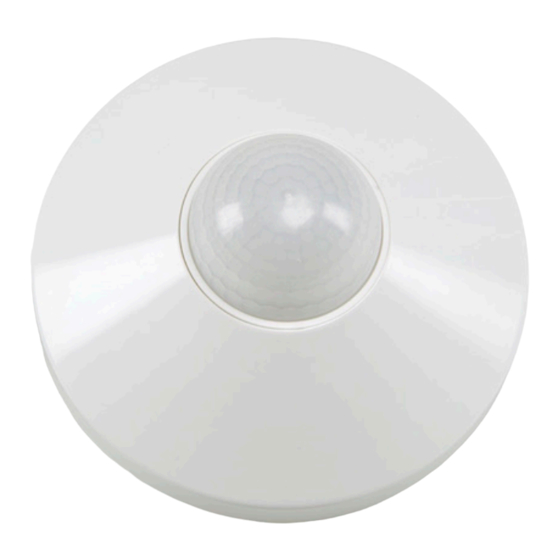
Advertisement
Quick Links
Dual Technology Ceiling Mount Motion Sensor SK806
User Manual
General
The SK806 is a ceiling mount motion sensor with PIR and Microphone dual
technology. The combination allows the sensor to detect motion and sound.
This sensor is ideal for larger areas, such as open plan offices and large rooms.
If, after reviewing this guide, you require additional information or assistance
please contact Eco Heat Equipment at info@ecoheat.co.za, +27 (0)861 999 887, or
www.ecoheat.co.za.
Technical Specifications
§ Voltage: 220 – 240V/AC
§ Frequency: 50/60Hz
§ Load: Incandescent: 1 000W
Fluorescent: 600W
§ Detection Range: 360 ° 1 – 10m radius
§ Light level: 10 – 2 000LUX
§ Time setting: 10 seconds – 30 minutes
§ Installation height: 3m max
Safety
Any incorrect use or installation procedure not recommended by the
manufacturer may cause fire, electrical shock or injury to persons.
Box Contents
Your box should contain the following items:
§ Sensor
Installation Instructions
WARNING: ALL WIRING MUST BE DONE IN ACCORDANCE WITH NATIONAL AND
LOCAL ELECTRICAL CODES AND STANDARDS.
Note: motion sensors respond to rapid changes in temperature so care should be
taken not to mount the device near a climate control source (i.e. heaters or air
conditioners). Hot or cold draughts will seem like body motion to the sensor and will
trigger the device. Recommended distance from climate control devices is 2m.
1. Turn power off at circuit breaker or fuse
2. Remove top cover from base of sensor
3. Connect wires as per diagram
4. Sensor can be secured onto ceiling with M5 butterfly screws or spring
toggle
5. Restore power at circuit breaker or fuse
The LED will switch on when power is restored and will stay on until the sensor is in
operation
Sensor calibration:
Note: Allow up to 1 minute for the motion sensor to recalibrate after it has been
connected for the very first time. This is only necessary during installation or when
the mains supply is disconnected.
-
© Eco Heat Equipment
August 2015
SK806
Operation and Field of View
The motion sensor detects motion within its coverage area and controls the
associated lighting connected to the sensor. The passive infra red (PIR) sensor is
sensitive to the heat emitted by the human body. In order to trigger the sensor the
source of heat must move from one zone of detection to another. The device is
most effective in sensing motion across its field of view and less effective sensing
motion towards or away from its field of view.
Sensor detection range from side: large motion
Sensor detection range from top: large motion
Motion Sensor Settings and Adjustments
The motion sensor is a Passive Infra Red (PIR) type electronic occupancy detector,
which in turn switches the lights when connected to the motion sensor. There are
four adjustments that can be made to influence the operation of the motion
sensor:
1. RANGE: motion detection range
2. TIME: time delay after motion/sound until shut off
3. LUX/LIGHT: level of ambient light sensitivity
4. MICROPHONE: use of sound as backup to motion detection to keep the
device on.
The four adjustments settings are as follows:
Detection range:
Time setting range:
Lux (light) sensitivity:
Microphone:
1 of 2
Installation wire diagram
1m to 10m
10sec to 30min
10 to 2 000 LUX
On/Off
Advertisement

Summary of Contents for Eco Sensor SK806
- Page 1 General most effective in sensing motion across its field of view and less effective sensing The SK806 is a ceiling mount motion sensor with PIR and Microphone dual motion towards or away from its field of view. technology. The combination allows the sensor to detect motion and sound.
- Page 2 Motion Sensor Adjustments Trouble Shooting Malfunction Possible Cause Remedy The unit will a. No mains power a. Check mains power is on not switch b. No movement is b. Move towards the unit (in “on” detected (in detection detection zone) or increase the zone) detection range settings c.
